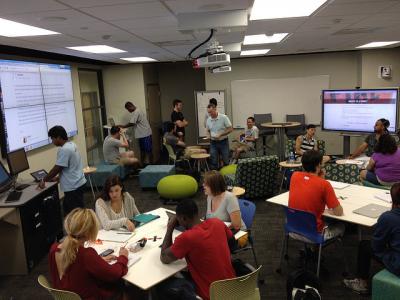Training and Collaboration
Posted on 30 November 2018
Training and Collaboration
 Image courtesy of Tom Woodward.
Image courtesy of Tom Woodward.By Raniere Silva, Software Sustainability Institute, and Aleksandra Nenadic, Software Sustainability Institute.
Educational psychology provides us with great findings about the process of human learning that can help educators provide more effective training to learners. Because their curriculum is sometimes full, many researchers, developers and publishers don't know about those findings when they start their careers as educators, just like researchers might be unfamiliar with best software developer practices because they weren't taught them. During our Collaborations Workshop 2019, attendees will have opportunity to learn from specialists about educational psychology and how to become better instructors. In the following paragraphs, we give an overview of have some of the principles and practices of educational psychology that we will be discussing at CW19 next April.
Cognitive Load
The process of learning happens when a learner’s working memory is loaded with new information which is processed and then transferred to long-term memory for storage and later retrieval. Humans have limited working memory capacities and can store only a few items for a short amount of time. In order for the new knowledge to be transferred into long-term memory, it must be actively applied. However, activities that make excessive demands on working memory are likely to induce cognitive overload – understanding new ideas can be impeded if students are confronted with too much information at once.
Techniques that can help with reducing cognitive load include using ‘faded’ or ‘worked’ examples. For example, an instructor can start showing students a problem and a detailed step-by-step solution, followed by a series of faded examples. The first of the faded examples presents a nearly-complete use of the same problem-solving strategy with a small number of blanks for the learner to fill in. The next problem is also of the same type, but has more blanks. And so on until the learner is asked to solve the entire (new, but related) problem on their own.
Another technique is using graphics, diagrams, concept maps or similar visual aids that help with conveying an idea when instructor is explaining it. If instructors ensure that the two types of information being presented complement one another — such as code being written on the screen and what they are speaking out loud — learning is enhanced. But if the two sources of information are different people’s attention is divided and learning is impaired due to an increased cognitive load.
Positive Learning Environment
Creating a positive learning environment is an important step on the road to successful learning — think how often in the past you have been motivated or demotivated by the learning environment. Instructors should be inclusive and set norms of conduct and interaction as learners might come from various academic and social backgrounds. For example, ensure that everyone is taking turn in discussions and encourage quieter people to contribute as well.
Is common for teachers to have students of different skill level. When juggling to motivate students by not making them feel inferior, instructors should be careful of "expert blind spot" — learners cannot see the world through expert's eyes so learners might not be familiar with things and connections between concepts that may seem trivial to the instructor. Another thing that helps instructors to deal with students of different skill levels is presenting themselves as a learner too and admitting that instructors do not know everything and show students that it is acceptable to make mistakes.
Giving and Receiving Feedback
Sometimes it can be hard to receive feedback, especially when it is negative. As an instructor, always word your feedback in a constructive way — focused on an specific issue, not the person, and offer ways of how to improve or fix things. "If you can't think of a constructive purpose for giving feedback, don't give it at all."
Learners and co-instructors should be encourage to provide feedback that can be collected in order to improve teaching practices and lessons. A good way of giving feedback to instructors is to balance positive and negative feedback (the so called ‘Feedback Sandwich’ - say something positive, then what can be improved, then something positive).
Collaborations Workshop 2019
In addition to the principles and practices mentioned before, we are interested in hosting discussions related to:
-
collaborative lesson development, on GitHub/GitLab, wiki or another platform;
-
best practices in lesson maintenance;
-
lesson study, a classroom action research to analyse learning and teaching.
Register now for Collaborations Workshop 2019 to find out ways to be a better instructor.
Want to discuss this post with us? Send us an email or contact us on Twitter @SoftwareSaved.

